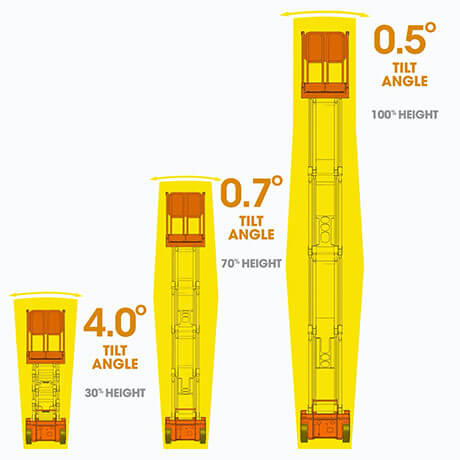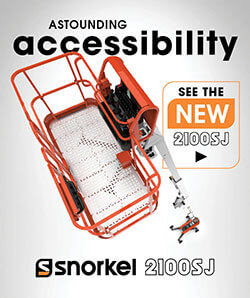 Operating a scissor lift on a slope can be a challenging task. Under ANSI A92.20 standards for the design of aerial lifts, machines must be equipped with tilt sensing capabilities. In addition to a tilt sensor alarm, a mechanism must be able to stop elevating functions in the event that a machine’s incline exceeds a designated slope limit.
Operating a scissor lift on a slope can be a challenging task. Under ANSI A92.20 standards for the design of aerial lifts, machines must be equipped with tilt sensing capabilities. In addition to a tilt sensor alarm, a mechanism must be able to stop elevating functions in the event that a machine’s incline exceeds a designated slope limit.
To provide operators with maximum usability, Snorkel incorporated a new variable tilt function on its line of scissor lifts from early 2020 that meets the latest ANSI and other ISO based standards. This solution is one of the most innovative variable tilt systems in the industry, maximizing lift performance without operator invention.
The feature allows the machines to be operated on greater side-to-side slopes while the platform is below its set height. As the platform is elevated, the degree of side-to-side slope on which the machines may operate decrease accordingly.
This new three-point design allows the machine to tilt at different angles at varying heights. Adjusting the envelope provides a larger margin without adding weight and still permits outdoor usage. Starting with the line of electric scissor lifts, Snorkel will be adapting the redesigned tilt points across many of its scissor lifts.
The variable tilt function is currently available on the Snorkel S3215L lightweight electric scissor lift along with the S3019E, S3215E, S3219E, S3220E, S3226E, S4726E, S4732E and S4740E electric scissor lift models.
EXAMPLE
Illustrated with Snorkel S3219E electric scissor lift
- From fully stowed to 7.5 ft. (2.3m) of elevation, the S3219E can be operated at the maximum tilt as listed in the operator’s manual and on the data tag of the unit. At this height, the scissor lift can operate at a maximum of 4° from side-to-side and 4° front-to-back.
- From 7.5 ft. up to 17.5 ft. (2.3m to 5.3m), the tilt operation, the tilt is limited to linearly changing angle starting at 4° and progressing to 0.7° from side-to-side. Front to back remains at 4°.
- From 17.5 ft. (5.3m) to full elevation, where it is most critical, the maximum tilt is also the most restricted. At these heights, the tilt is again changes linearly starting at 0.7° to 0.5° side-to-side by the time max height is reached. Front to back remains at 4°.
For more information on Snorkel electric scissor lifts, visit https://www.snorkellifts.com/equipment/category/Scissor-Lifts/Electric-Scissor-Lifts.
Reference TCB19.020



